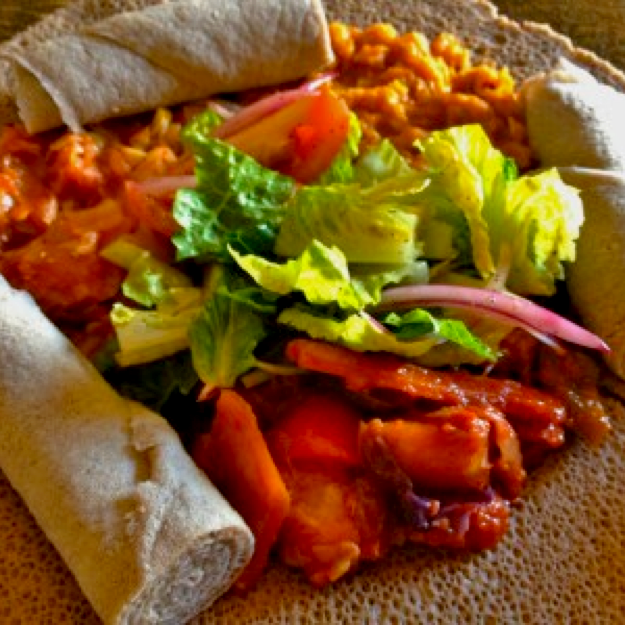
Abel Woldemichael is tired of having his restaurant confined to “ethnic cuisine.” Late on a Friday night, Muzita, an Ethiopian bistro in San Diego, has finally quieted down. The young proprietor, a CPA by day with chin-length dreadlocks, tells us about his passion for mainstreaming Ethiopian food. “When someone says, ‘Let’s go out,’ I want them to say, ‘Shall we have Italian, French, or Ethiopian?’”
Woldemichael opened Muzita in the University Heights neighborhood of San Diego in 2008. The restaurant has garnered awards from Urban Spoon, Citysearch, the San Diego Tribune, and OpenTable.com, including “most romantic,” “best vegetarian,” and “top ten overall.”
The decor at Muzita Bistro is modern, but the food is wonderfully traditional.
When my friend Claire and I bumbled in, reservation-less, at 8:30 on a Friday night, Muzita was slammed. Diners occupied every table. Folks stood outside on the sidewalk. I could barely get in the door to request a seat. But the staff managed to be friendly, unrattled by the crowd and even displayed a sense of humor. They found us a table within 15 minutes.
Finger Food
We settled into a corner table for two and leaned in to converse. Despite Muzita’s awards for romance, this place is loud on a Friday night. If you’re on a date, the small side patio is preferable. Voices raised, we contemplated the menu. Vegetarians can choose from five main dishes. The shiro, a ground chickpea dish, tempted me. But I’d eaten little in the way of vegetables that day so decided hamli, braised collards and spinach, was in my best interest. Claire chose kantisha kilwa, which is zuchini, button mushrooms and stewed tomatoes. The other veg choices included seasonal stewed vegetables and a dish made with silken tofu. All these entrees are vegan except for kantisha kilwa, which includes butter. Each entrée comes with a side. I chose lentils berbere. Claire picked cabbage.
Dishes like this shiro, a chickpea stew, make it easy for vegans and vegetarians to find something delicious to eat. Photo Emily Uhre.
If you’re new to Ethiopian cuisine, don’t waste time looking for a fork. This is finger food. Our dinner appeared on one big piece of injera bread sitting on one big plate. Ethiopians cook this fermented flat bread from a grain called teff. Some of Ethiopia’s famed long-distance runners attribute their endurance to the protein, iron, calcium and fiber found in this tiny grain. Abel brought some of the uncooked grain out of the kitchen to show diners at the next table. Each granule is much smaller than rice, barley or other familiar grains.
Claire yearned for a fork. Roberto, our server, caught her scooping cabbage with the spoon she’d used to stir her tea. “Are you cheating?!” he asked good-naturedly. She reluctantly laid down her spoon and pulled off a strip of injera to wrap around her vegetables, just like an Ethiopian.
Germophobes might not like this dining style. You’ll definitely want all the members of your table to wash their hands first. In fact, Ethiopians ritually wash their hands in a bowl of water before and after every meal. I’m comfortable eating the injera and cooked vegetables by hand, but felt a bit barbaric when eating the green salad. Reaching to the middle of the table, instead of to an individual plate, also felt strange, and increased the odds of dropping food before it arrived safely to my mouth.
Delicious
While I’d chosen the greens mostly for nutrition’s sake, they turned out to be the best thing we ordered. The finely-chopped collard greens and spinach took their flavor from onions and spices. Tomato lovers will enjoy the kantisha kilwa, which is heavy on the tomatoes and lighter on zucchini and mushrooms, with a buttery flavor. The lentils berbere were smooth, mild and golden. While the main ingredient of berbere sauce is chilis, these lentils tasted mostly devoid of spice. I requested a side of Muzita’s house-made chili sauce.
All Muzita’s recipes originate from the head chef: Abel’s mom. She works in the kitchen during the day shift, preparing all the sauces. This gives the owner an even more personal connection to his restaurant. These are the recipes he’s eaten all his life, prepared for him with love in times of happiness and sorrow.
Fasting Food
Abel enlightened me about Ethiopia’s fascinating vegan tradition. Coptic Christians abstain from meat on Wednesdays and Fridays, and for 40 days before Advent and 56 days before Lent. All together, they observe about 250 fasting days each year. While fish is permitted, it’s usually expensive and difficult to transport. So during fasting days ordinary Ethiopians stick to foods of vegetable origin. Dishes usually revolve around potatoes, kale, pumpkin, or legumes.
The outdoor balcony at Muzita can be a quieter dining option.
“I didn’t know about vegan food at the beginning,” Abel said. When he first opened Muzita, he listed vegetarian dishes on the menu, but didn’t separate out those that were vegan. When he realized people wanted what he knew as “fasting food,” serving them became easy.
Because of the fasting food tradition, Muzita can serve authentic recipes without having to alter them for vegetarians. “Other places take recipes and use meat substitutes, but Ethiopian food has lots of foods that are naturally vegan. So you’re eating the recipe just how it’s supposed to be made,” Abel said. Abel’s family jokes that they can add meat to their traditional dishes to please customers.
Abel and his family have been in San Diego for 30 years now. While San Diego is far from the kingdom of Ethiopia, talking to the owner gave us a feeling of personal connection. Late on a Friday night on the Pacific coast, we were eating kantisha kilwa, Abel’s favorite food when he was a boy growing up by the Red Sea. And as a vegetarian, I would say it outranks French, Italian and sushi any day.
— Teresa Bergen, RFT Vegan/Vegetarian Editor
